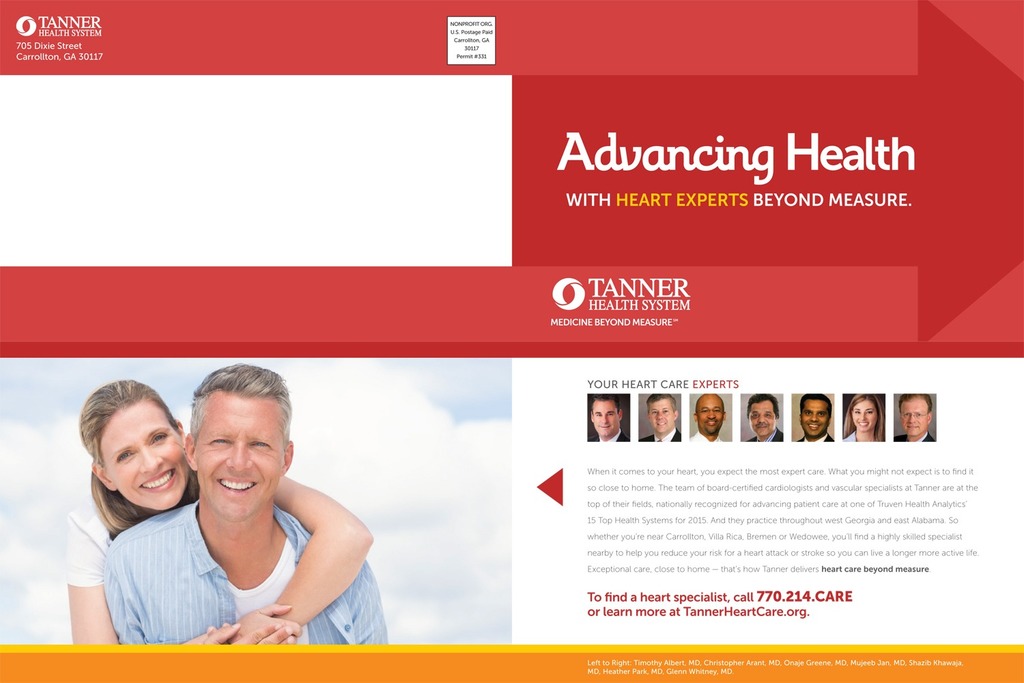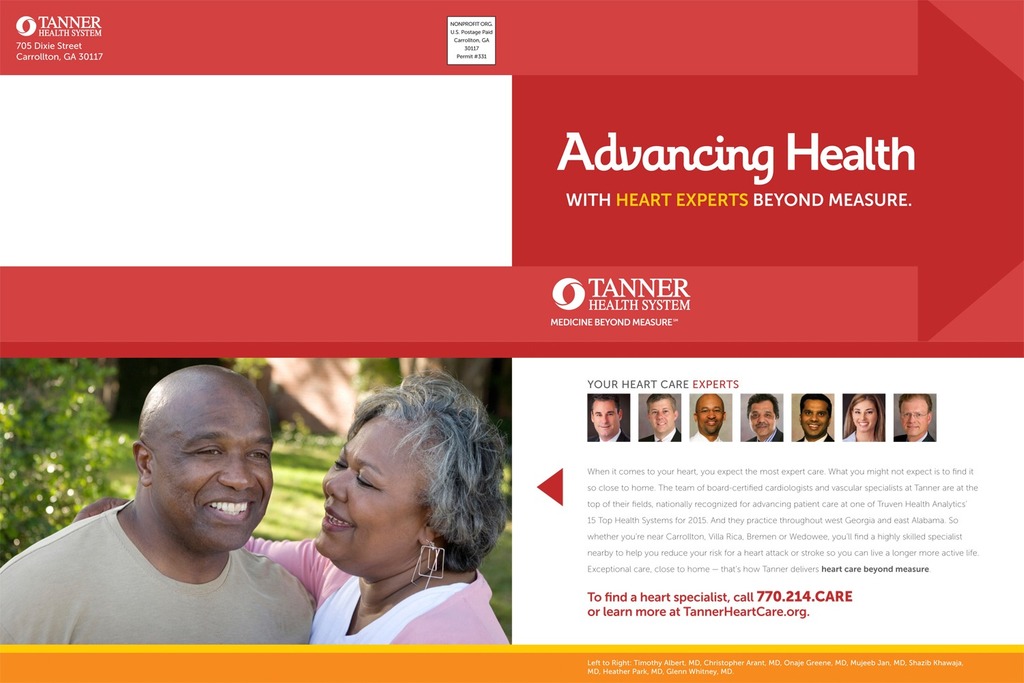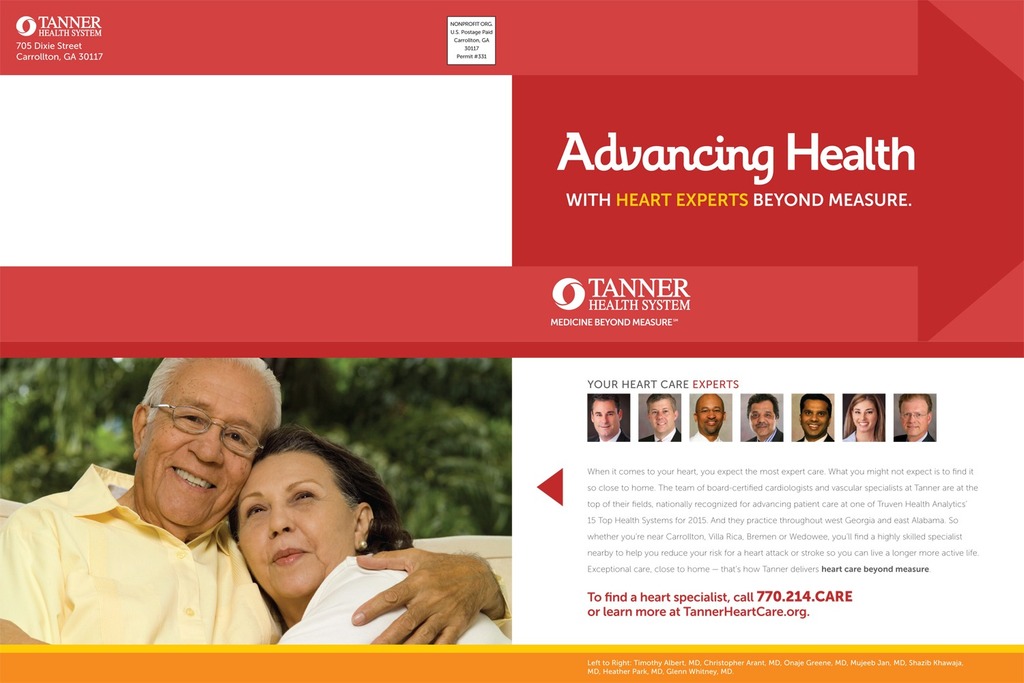Tanner Health System Uses Micro-Targeted Data to Strengthen Its Marketing Efforts
// By Lisa D. Ellis //
 When its market share began dwindling recently, Tanner Health System turned to micro-targeted data to step up its marketing efforts and make them more efficient.
When its market share began dwindling recently, Tanner Health System turned to micro-targeted data to step up its marketing efforts and make them more efficient.
Using Data to Hone Marketing Efforts
As a nonprofit health system serving nine counties in rural west Georgia and east Alabama, Tanner has more than 350 physicians representing 34 unique medical specialties, and runs Tanner Medical Center/Carrollton, a 201-bed acute care facility; Tanner Medical Center/Villa Rica, a 40-bed acute care center; Higgins General Hospital in Bremen, a 25-bed critical access center; and Willowbrooke at Tanner in Villa Rica, an 82-bed behavioral health facility.
With such a large system to manage, Tanner’s C-suite and marketing department recognize the importance of using key data findings to guide their marketing efforts. Yet until recently, the system’s main sources of information were limited to the basics such as electronic medical records, census bureau results, and general facts about the service area.

Kelly Meigs, director of marketing and public relations at Tanner Health System
“We also had data from the Georgia Hospital Association, but it wasn’t accessible visually, in the form of maps, graphs, or charts,” says Kelly Meigs, director of marketing and public relations at Tanner. She says this meant her team was challenged in being able to show trends and targets, and in making sure Tanner’s marketing approach was aligned properly for the realities of the region and the people it served. With shrinking budgets and dwindling market share over the past few years to contend with, the organization really needed stronger information to be more strategic in positioning itself in the marketplace and making sure every dollar invested in marketing led to some form of payoff in the end.
Expanding Cardiology Services
Tanner decided to focus on expanding its cardiology service line, and wanted to be very calculated in determining where to invest its advertising/marketing dollars for maximum return on investment (ROI).Of particular interest was a region Tanner refers to as the “northern arc,” which was in the top corner of its service area and which it had not explored before. Meigs says there seemed to be a lot of untapped potential in this area.
“As part of the decision to expand our cardiology service line, we did an in-depth analysis to look at the overall market value and at how it had shifted over time,” she points out.
Seeking Help from the Experts
At the time, Tanner’s marketing department was already working with Stratasan in Nashville, Tennessee, a company that provides a software platform and data analysis that helps organizations understand their strengths, weakness, and opportunities for growth. Stratasan offered to help Tanner address this latest challenge using a micro-targeting process to capture more specific data that could inform marketing efforts and help Tanner be more effective.
The process involved looking at block groups and tapestry segments [67 specific segments that are used to describe the characteristics of neighborhoods and the people who live in them], which offered an opportunity for conducting a micro marketing analysis and using the findings to guide more strategic marketing efforts.
Meigs and her staff were excited to try this deeper data approach. Of all the data vendors available, Tanner chose to work with Stratasan because of their established relationship and trust. Meigs felt the Stratasan team already knew Tanner and understood the organization and its goals. Stratasan also offered a process that seemed like a perfect fit.
“We had created this tool at the micro-level to be able to go below a ZIP code level, since large mailings can be cost-prohibitive, ineffective, and hard to measure,” says Lee Ann Lambdin, FACHE, senior vice president of health care strategy for Stratasan.

Lee Ann Lambdin, FACHE, senior vice president of healthcare strategy for Stratasan
“We looked at things like credit card spending and loyalty card savings,” she adds. “You can see what types of patients come to you and see what tapestry they fit within.” This information enabled Stratasan and Tanner to understand which tapestries were using cardiology services. This made it possible to see people in other ZIP codes that fell within those same tapestries that were not yet in the Tanner system but offered some strong potential.
The result was to create a highly targeted ad campaign for Tanner’s cardiology line, with a range of publicity efforts, digital ads, videos, and mailers.
The marketing department also used psychographics to create the campaign. Psychographics go deeper than demographics (factual information) to include people’s habits and preferences, looks, value systems, and other key details that enabled Tanner to create a campaign that was very specifically targeted to the appropriate audience. Specifically, this meant that Tanner took the same ad and tailored it for different age groups so they would relate to the message. For instance, for an older population, they used a model who had gray hair. For the 55 age group, they used a model who looked about 48, since Meigs says people typically relate to someone slightly younger than they are.
“What was interesting was that our micro-targeted groups were very close geographically,” Meigs says. “Even if they had a lot of tapestry segments, they also had a lot of similarities. By breaking neighborhoods down in such specific ways, she points out that instead of sending out a bulk marketing mailing to a ZIP code or neighborhood, Tanner could focus more closely on people within a defined age group or who possess certain defined characteristics to target the most promising prospects.
“In the past, direct mail has been very successful for us, but as the service area grows, it is also very expensive,” she says. “We could pull mailing lists of certain age groups and characteristics but couldn’t pull a propensity for a disease, target outmigration, or see market share for a particular block group,” she adds.
With the micro-targeted data, though, Tanner was able to narrow in on people who would specifically be interested in the information provided, which helped weed down the printed material produced and mailed.
“We had a community newsletter that originally went out to 100,000 people, but then our service area grew to 300,000 and it became too expensive to print and mail to all of them,” Meigs says. While the organization considered printing less frequently, she feared this would weaken the newsletter’s impact. Instead, she decided to streamline the mailing list and send it only to the people with the highest likelihood of using the health system’s services.
Meigs says she also looked at each direct mail piece and tried to determine what characteristics would be the best fit for the service they were promoting. “Stratasan helped us narrow in on the best strategy and also helped us with the patient data,” she says. This was quite cost-effective in the end as it meant that mailings were much less expensive since they were much smaller and more targeted, but they also brought in bigger results.
This micro-targeted approach really helps us manage our budget. Now instead of sending 100,000 direct mail pieces, we can send just 10,000 or even fewer.”
—Kelly Meigs, director of marketing and public relations at Tanner Health System
“This allowed us to create movement in an area where we wanted to grow and now we can track our progress,” she says. “In the past, we had to do things manually. For instance, if we had various vein screenings in a particular physician’s office, we had to manually work with the office manager to get a list of names of patients who had received the screening.” This was a painstaking and time-consuming process to capture a list of people who might be appropriate for mailings about things related to veins and heart health.
“Now, we can look at micro-targeted data in detail and find people who have proven to be closely aligned,” Meigs says. “This micro-targeted approach really helps us manage our budget. Now instead of sending 100,000 direct mail pieces, we can send just 10,000 or even fewer,” she stresses.
Tanner faced challenges, Meigs says, defining the target audiences and goals and finding a common language to describe the detailed data so everyone understood it. In the end, she points out that they used two levels of reporting, one on a more general level for C-suite and one that was more in-depth for the marketing staff.
Achieving Results
The results of the efforts speak for themselves, with patient visits on the rise again in less than a year of trying this new approach. In fact, Tanner had 40 more commercial visits and 39 more Medicare visits in target blocks in the first quarter alone.
Moving forward, Meigs says Tanner plans to continue relying on a micro-targeted data brand-building process, going beyond the cardiac line to also market other service lines to the most appropriate audiences.
“Many organizations are afraid to get involved with data vendors because they think it will be too expensive,” Meigs says, but as Tanner has learned firsthand, it can actually save money by cutting down on advertising costs. “I encourage other groups to start with one project and see the results for themselves,” she adds.
Advice for Other Groups
If you want to make your marketing efforts more strategic, a good place to start is by defining your goals so you can determine what type of micro-data you need to narrow in on the best target audience, according to Lee Ann Lambdin, FACHE, senior vice president of health care strategy for Stratasan.
“Some groups just want a great payer mix to improve value,” she says, “while others may want to improve community health.”
Regardless of your goals, you can get ZIP code data and then begin drilling down by the attributes you desire, narrowing by gender, age, income bracket, and other details.
Lambdin says, while any group can benefit from such micro-targeted data, it would be tough to do effectively in an extremely rural area. An organization also needs access to a geo-coding system or they need to be able to at least geocode their own patient data.
But even the best—and most focused—data isn’t enough without a good story to tell. “You need to have a good hospital and good doctors and good messaging” to be successful, she stresses.
Lisa D. Ellis is the editor of Strategic Health Care Marketing. She is a journalist and content development specialist who helps hospitals and other health care providers and organizations shape strategic messages and communicate them to their target audiences. You can reach her at editor@strategicHCmarketing.com.



